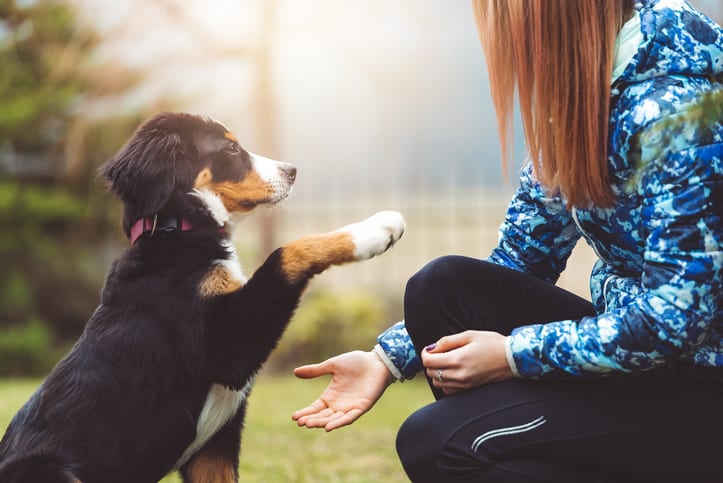What You Need to Know About Puppy Training in Limerick, PA
So, you’ve decided to get a puppy. Yay! This is such and exciting time in your life and in your new pup. By now you’ve researched breeds, checked out shelters, and found the perfect fit. With so much going on, you might be wondering what the best way to start training is. No one wants to end up with a poorly behaved dog. The good news is that all puppies are willing and ready to learn from you the moment you bring them home and every interaction they have with you and other humans and animals is a potential lesson.
Different Types of Puppy Training in Limerick, PA
Before you bring home your new best friend, you should do some research about puppy training. There are plenty of methods and everyone has a different idea about what’s important. There’s potty training, leash training, crate training, commands, and training on how to properly greet a human or other dog. It can absolutely be overwhelming. But, at 7 or 8 weeks, puppies can start to learn commands and how to properly behave so that’s the best time to start. Let’s talk about some of these different training types.
Potty Training Your Dog
Potty training is probably one of the most important things you’ll do when you first bring home your puppy. You want to get the accidents to stop as quickly as possible and you want your puppy to learn to hold it until he’s outside. With any training, the main key is to keep a consistent routine. This means daily feedings, potty times, crate training, and play time should be about the same every day. Dogs love routine and a predictable day. You should start by taking your puppy out about 10-15 minutes after feedings. You want to also take them out right after meeting new people, waking up from a nap, and before or after you crate them. You also want to make sure to not give them free reign of the house right away. Use baby gates and shut doors to create a smaller space. Lack of supervision often leads to accidents. When your puppy does go outside immediately give them a treat while you’re out there so that they associate the task of using the bathroom outside as a good thing. Lastly, never punish your dog for having an accident. They happen to everyone! Only reward good behavior, never punish the bad.
Crate Training Your Dog
Another important training is crate training. You want your puppy to associate his crate as a safe and happy place, not as a punishment. Dogs avoid defecating where they sleep, so crate training assists with potty training, too! Your crate should be large enough for your puppy to stand up and turn around comfortably in. If you chose a large breed, you might want to start off with a big crate so that you aren’t buying a new one every few months. The crate should be in a populated part of the house so that it isn’t associated with being locked away. This means avoid the basement or garage. Start introducing your puppy to the crate by leaving the door open and putting tasty treats inside. It’s important to let him discover the crate without it being locked so that fear isn’t associated with it. Next, start feeding inside of the crate and leaving it shut during and for a few minutes after the meal. After about 5-10 minutes inside the crate, take him out for a potty break. Keep a rotation of fun toys inside the crate and slowly work your way up with the time he’s inside of it. Soon, he won’t mind being crated at all!
Teach Basic Commands
Next, you’ll want to start on commands. Sit, stay, and lay down are all great starters. To teach a command, say it once and then gently push on your puppy to show them what you want. Once they’ve sat, you can give them a treat. Commands are all about positive reinforcement. On average, it takes about 15-20 tries for them to get it right so be patient. After your pup starts to get it, try to do it without the treat. Say the command once and then wait a few seconds. Ideally, don’t repeat the command. Then, reward with a pat on the head and a “good boy”. It’s also good to be consistent in the timing of your command training. Repeat the process with all of the command words you want to teach.

Leash Training Your Dog
The best way to start leash training is to start with a baseline test. Take your pup out for a short walk at a quiet time of day and see how he does. Then, you can work on things from there. For most dogs, it’s best to start in the backyard or on a deck where there’s less noise and distraction. Reward with treats and praise for good behavior, like when he walks by your side or sits on command. Relax the leash pressure and walk at a brisk pace. If your puppy is focusing on you then you want have to worry about distractions. The more you practice, the better your puppy will be! Quick word of caution, if you have a really bad experience when they’re really young, wait a couple of weeks and try again. Sometimes it can be too hard when they’re very little.
Stay Positive When Dog Training in Limerick, PA
Some final tips on socializing your puppy and making sure they’re well-behaved in all scenarios. Take your puppy on car rides so they aren’t scared. You don’t want them to only be in the car on the way to the veterinarian. They’ll start to associate the car with negative feelings. Don’t overwhelm or force your puppy to do anything. Take it slow and read their body language. You’ll know when to back off. Keep your puppy stimulated at home with treats and training and only use positive reinforcement. Saying no is perfectly fine, but you never want to hit or be aggressive with your puppy. A firm no is enough. Remember, train your puppy to behave like you want and you’ll have the best companion for years to come.
